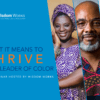MBA students have pinker hair and more facial piercings than they did a few years ago. To be sure, there are buttoned-up, power-tie types here as well, along with plenty of students dressed somewhere in-between. I’m standing before a sea of laptops at the Daniels College of Business at the University of Denver, and I’m here to talk about collaboration, leadership, and sustainability.
Dr. Bruce Hutton introduces me. He’s the professor of this Sustainable Enterprise program, a Dean Emeritus at the school, and a pioneer in corporate citizenship. To break the ice I have the students stand and stretch. In corporate settings this usually earns a snicker or two, but the students simply oblige. Hmm: ice not yet broken.
I ask, “Who here works in the corporate world?” Half the hands go up, but gingerly. This is not a room of seasoned execs, so I’m adapting my presentation on the fly, searching for ways to convey why collaboration is a necessity for sustainable business leadership. I’m describing how challenging this can be when a student raises his hand. He asks, “Why would collaboration even be difficult? I don’t get the problem.” The other students are nodding in agreement with him. For a moment my mouth hangs open and I’m sure I look like a deer in the headlights. In over 20 years I haven’t worked with a single organization where collaboration wasn’t a problem.
I’m quick to remind myself that most of these students haven’t fully experienced the real-life leadership aches and pains of trying to achieve positive business results through relationships. Whether these relationships are with employees, suppliers, business partners, or consumers, it means working with people who (rightly) have minds of their own. The challenges can be similar to managing relationships in our personal lives. I ask the student for a relationship that isn’t going well in his life. And then I dig further: “Why isn’t it working?” He answers: “Broken trust.”
Now we’re onto something. Trust. A key to the values and actions of every responsible organization. And, according to the latest global business results from the Edelman Trust Barometer along with countless blogs and editorials, trust is in short supply in the world today… and declining. I ask the class, “What is trust?” They are bold; many hands go up. One student describes trust as “a repeated pattern of dependability.” Nice response.
I take this definition one step further, by drawing on the thoughts of a colleague: Dr. Julio Olalla. I’ve always liked how he describes trust as a precondition for coordinating action. It’s the same in just about any relationship: no trust, no effectiveness. Olalla goes on to describe three distinct elements of trust. Anyone can use these to assess whether the foundation exists in a relationship to accomplish something meaningful and constructive:
- Sincerity: Is the other person or people in the relationship authentic and transparent in their motivations and commitments? Are you?
- Competence: Are they capable of performing the necessary skills with excellence? Are you?
- Reliability: Do they keep their commitments, honoring what they say they will do? Do you?
Trust is a two-way street. It takes commitment and discipline from both sides. Judging from the students I met at the University of Denver, the traffic on this two-way street will increasingly have unexpected hair colors and what the younger generation calls “hardware” on their faces. What’s really important, however, is that these students are asking the right questions, reflecting on the fundamental ideals shaping leadership, and showing a refreshingly frank concern for integrity in business. Now that’s the kind of businesspeople we can trust.
Photo by AH!Photography.





